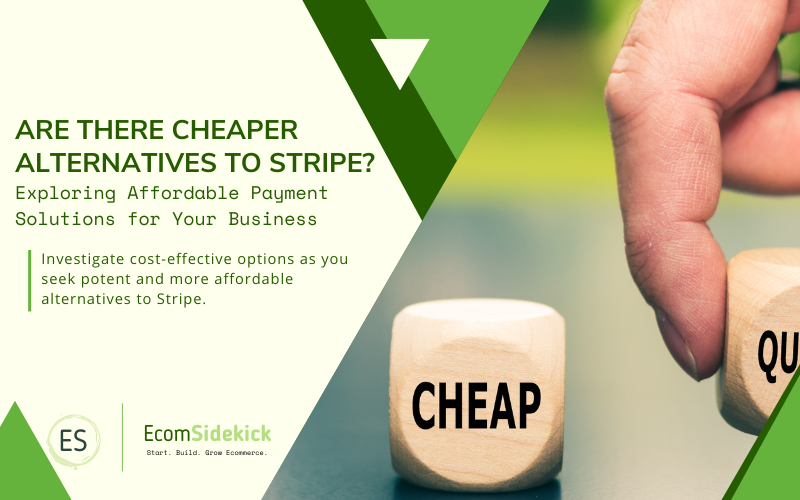Stripe may well be an excellent payment platform for internet businesses, but when this article was written, Stripe was still charging a fee for every single transaction made. And for many businesses that make a lot of sales, this can soon start to add up. What’s more, it also cuts into the profit margins for every product or service sold. And that’s far from ideal.
That’s why it pays to look into alternative platforms that may work out cheaper to use, keeping more of your business profits in the account where it belongs.

Are there cheaper alternatives to Stripe? In this article, we’re going to explore and assess some of the alternative online payment processing platforms. But we’ll kick things off by looking at the benefits of Stripe, so that we can make better comparisons.
By the end of the article, when we reach our final conclusion, you will be much more well-informed of the alternatives available, and will be in a much better position to decide which is the right option for your business.
Please feel free to scroll ahead to any section that jumps out at you. Here goes!
What Are The Benefits Of Using Stripe As An Online Payment Processor?
Stripe offers a number of advantages over other online payment processors. These include:
Stripe |
|
So what do these benefits mean for you? Well, they give you access to a huge array of tools and services that can help you grow your business. For example, if you want to create a subscription based service, then Stripe makes this really simple.
You can also integrate with popular applications such as Mailchimp and Zapier. This means that you can automate processes and save time.
But perhaps the most important benefit of all is their price structure. As mentioned earlier, Stripe charges a flat rate per transaction. This means that even though you might only sell one item each month, you won’t pay anything extra on top of that.
But Stripe is not your only option, and there are several alternatives that can rival it. Let’s take a look.
Are There Cheaper Alternatives to Stripe?

PayPal
PayPal will be one you’ve already heard of, having made its name through eBay. However, while PayPal does have its uses, it isn’t always the best solution.
For example, you can’t use PayPal as a standalone payment provider. Instead, you must link it to another website or application. That’s fine for smaller transactions, but if you’re selling products or services worth thousands of pounds, it could prove problematic.
Also, although PayPal has a great reputation for security, it doesn’t always live up to expectations. It was recently revealed that hackers had breached the system and stolen customer data. So if you’re worried about security, you should probably steer clear.
Square
Square is a mobile app that allows users to accept credit cards and cash from customers. It works in conjunction with a small device called a “square terminal”.
The square terminal plugs into your computer via USB and connects directly to your bank accounts. Once connected, you can start accepting payments straight away.
However, the main drawback with Square is that you’ll need to install the software yourself. If you’re looking to get started quickly, this may be a problem. Also, because it’s a separate piece of hardware, it’s likely to cost you money.
Google Wallet
Google Wallet is Google’s own alternative to PayPal. Just like PayPal, it’s designed to make it easier for people to pay for things online.
However, unlike PayPal, Google Wallet is integrated with Google Checkout. This means that when someone buys something using Google Wallet, they automatically receive an email confirming the purchase. This is handy because it saves you from needing to manually send out emails. And it also ensures that you know who bought what.
However, Google Wallet is currently only available in the US, which limits its appeal. Also, it only supports credit card purchases at the moment. So, if you’re looking for a more flexible way to process payments, Google Wallet might not be the best choice.
Amazon Payments
Amazon Payments is a cloud-based service that lets you accept payments from anyone anywhere in the world. The good thing about Amazon Payments is that it’s free to set up. And it’s not just for selling as an Amazon affiliate, because you can use it on any website.
But Amazon Payments has some drawbacks too. For example, it’s limited to credit cards and debit cards at the moment.
It’s also restricted to certain countries, so if you want to expand beyond the US, you’ll need to find another option.
PayPal |
| |
Amazon Payments |
| |
Braintree |
| |
Stripe |
|
Final Thoughts

If you’re serious about starting a business, you’ll need a reliable payment processor. Otherwise, you could end up losing lots of money before you’ve made a profit.
We would argue that Stripe is one of the more reliable payment processors out there, and for this reason we would recommend that despite the fee for each transaction, it may still be the best option for your business.
We also recommend picking one payment platform and sticking with it, in order to save yourself the hassle of moving between different payment platforms.
Frequently Asked Questions
What Is Stripe, and Why Is It Popular Among Businesses?
Stripe is a third-party payment gateway that allows businesses to accept online payments. It’s popular due to its ease of use, developer-friendly API, and seamless integration with various e-commerce platforms.
What Are Some Potential Reasons for Seeking Cheaper Alternatives to Stripe?
Businesses might explore cheaper alternatives to Stripe to reduce transaction fees, especially for high-volume sales, or to find a solution that better aligns with their budget constraints.
What Are Some Alternative Payment Gateways That Offer Competitive Pricing?
There are several payment gateways that offer competitive pricing compared to Stripe. Some popular alternatives include PayPal, Square, Braintree (owned by PayPal), 2Checkout, and Authorize.Net.
Paul Martinez is the founder of EcomSidekick.com. He is an expert in the areas of finance, real estate, eCommerce, traffic and conversion.
Join him on EcomSidekick.com to learn how to improve your financial life and excel in these areas. Before starting this media site, Paul built from scratch and managed two multi-million dollar companies. One in the real estate sector and one in the eCommerce sector.





